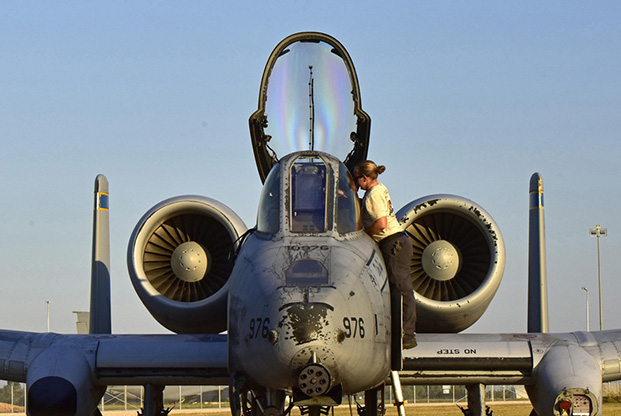
Maintainers perform final preflight procedures for an MQ-9 Reaper before takeoff on a combat flight for OIR. USAF photo by SrA. Damon Kasberg
The Air Force runs two ongoing air wars. One is Operation Inherent Resolve against ISIS in Syria and Iraq; the other is Operation Freedom’s Sentinel, targeting al Qaeda, the Taliban, and other terrorists in Afghanistan and elsewhere. The efforts are launched from a constellation of bases scattered throughout the Middle East, ranging from massive flight lines in allied countries to small, dusty airstrips close to the front lines.
Air assets, including the most modern stealth fighters, massive lumbering B-52 bombers, and the full range of intelligence, surveillance, and reconnaissance gatherers, take off from around the region, kept aloft by KC-135s and KC-10s deployed to regional air bases that are integral to ongoing wars.
The 380th Air Expeditionary Wing at Al Dhafra AB, United Arab Emirates, is a keystone of these operations. The wing’s approximately 3,000 airmen are at a base that for years was referred to only as an “undisclosed location.” Al Dhafra is a rare air base where “every one of our five core missions” are handled, then-Wing Commander Brig. Gen. Charles S. Corcoran said in an interview with Air Force Magazine in May.
The wing is host to about one-fourth of the Air Force’s entire KC-10 fleet, flying constantly for Operation Inherent Resolve in Iraq and Syria. U-2 Dragon Lady spyplanes and RQ-4 Global Hawks gather intelligence, splitting their time between OIR and Afghanistan. Al Dhafra is the only base in US Central Command that supports both these airframes. Four E-3 Sentry airborne warning and control system aircraft control the battlespace daily.
Meanwhile, a contingent of F-22s rule the skies over Iraq and Syria from the base along with F-15E Strike Eagles, Corcoran said.
Supporting these diverse aircraft brings a “huge sense of pride” to the thousands of airmen at the base. “They buy into the ‘why,’?” Corcoran said. “They’ll do anything for you. [They are] proud of what they are doing.”
Farther north along the Persian Gulf is the Air Force’s biggest base in the region, the sprawling Al Udeid Air Base near Doha, Qatar, where all regional airpower is controlled in the base’s state-of-the-art combined air and space operations center (CAOC). The tightly secured complex controls both air wars and all the airlift and air refueling.
“When you look at being expeditionary, there’s really nobody else who does this business the way we do,” said Brig. Gen. John B. Williams, the director of mobility forces at the CAOC, in a recent interview with Air Force Magazine.
The Al Udeid flight line has dozens of KC-135s from all components across the Air Force, lining up to take off to keep combat and ISR aircraft aloft in two air wars. Air Force C-17s and C-130s work with the massive aerial port at the base to keep the wars supplied. This includes flying to small, austere locations inside Iraq and Syria to keep frontline forces ready in the fight against ISIS.
“There are dynamic requirements that pop up out of nowhere,” said Lt. Col Aaron Lane, the operations officer for the 8th Expeditionary Air Mobility Squadron at Al Udeid. “We jump into action to provide that as quickly as we can.” For the most part, this has included bullets and other small-arms ammunition for US-backed fighters, although there’s also been a need for blood, food, and other humanitarian supplies.
In addition to mobility assets, Al Udeid’s flight line has E-8C JSTARS aircraft flying constantly to track ISIS fighters in the region and B-52 Stratofortress bombers to destroy them. The B-52s first deployed to the base in spring 2016 and have been an integral part of a large increase in air strikes since they’ve arrived in theater. As of July 31, US and coalition aircraft had conducted 27,726 air strikes on ISIS targets in Iraq and Syria, a pace well ahead of 2016’s overall total of 30,743.
B-52s have also been a large part of air strikes in Afghanistan, complementing the USAF F-16s that are deployed to Bagram Airfield there.
Stratofortresses are tasked with flying to Afghanistan on average about once per week, Maj. Gen. James B. Hecker, the commander of NATO Air Command-Afghanistan and the 9th Air and Space Expeditionary Task Force-Afghanistan, told Air Force Magazine in Kabul recently. This pace is expected to increase as the US surges troops to Afghanistan again this year.
Throughout US Central Command, there are about 20,000 US and international airmen deployed to the region. Over three years, those airmen have contributed to more than 94,000 bombs dropped against ISIS targets, former Air Forces Central Command Commander Lt. Gen. Jeffrey L. Harrigian wrote in a letter to airmen before leaving the post in August. These airmen and aircraft have worked to “pummel ISIS into a remnant of its former self, unable to focus because of a daily forecast of punishing airpower.”
